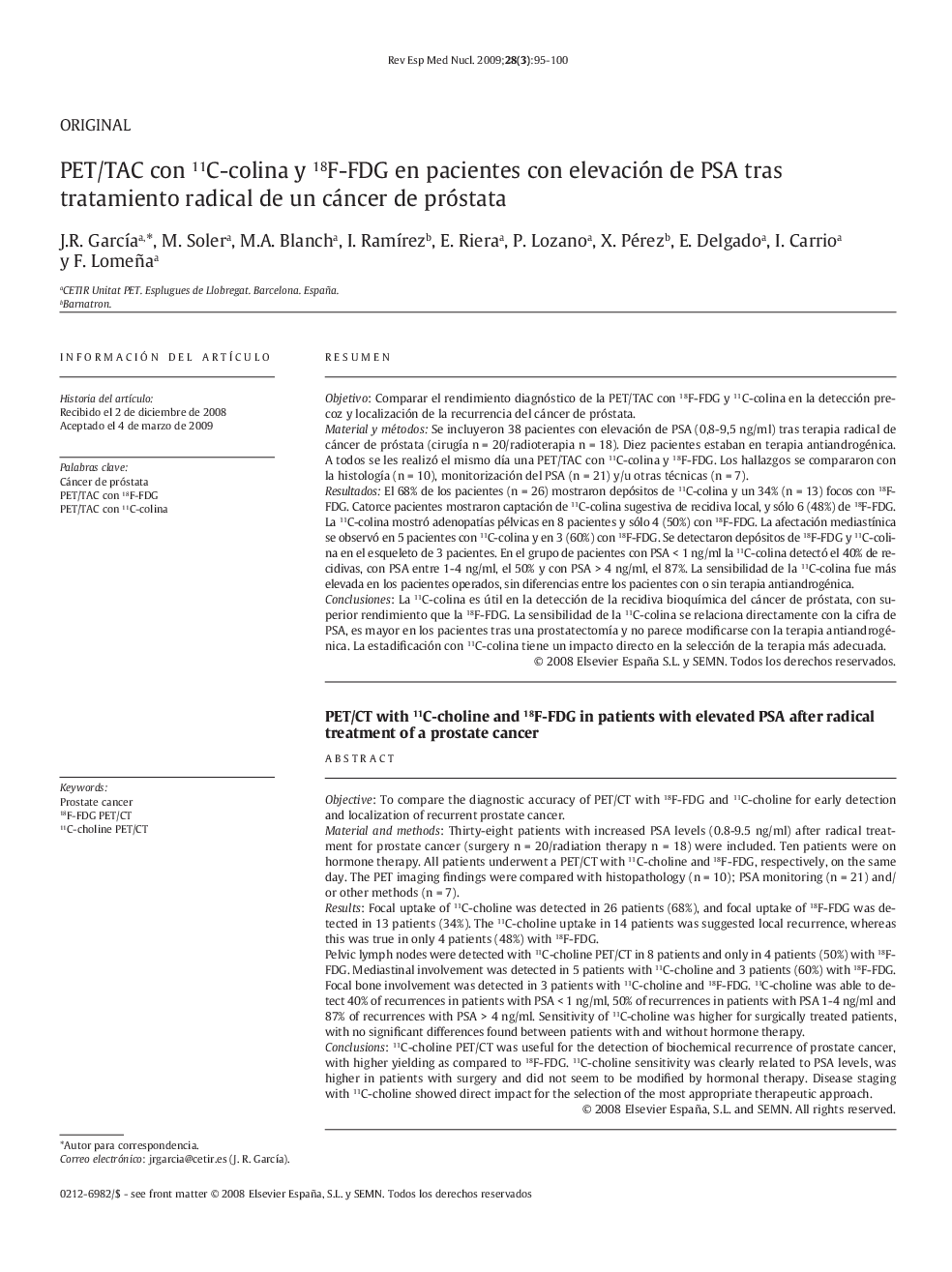| Article ID | Journal | Published Year | Pages | File Type |
|---|---|---|---|---|
| 4249104 | Revista Española de Medicina Nuclear | 2009 | 6 Pages |
ResumenObjetivoComparar el rendimiento diagnóstico de la PET/TAC con 18F-FDG y 11C-colina en la detección precoz y localización de la recurrencia del cáncer de próstata.Material y métodosSe incluyeron 38 pacientes con elevación de PSA (0,8-9,5 ng/ml) tras terapia radical de cáncer de próstata (cirugía n = 20/radioterapia n = 18). Diez pacientes estaban en terapia antiandrogénica. A todos se les realizó el mismo día una PET/TAC con 11C-colina y 18F-FDG. Los hallazgos se compararon con la histología (n = 10), monitorización del PSA (n = 21) y/u otras técnicas (n = 7).ResultadosEl 68% de los pacientes (n = 26) mostraron depósitos de 11C-colina y un 34% (n = 13) focos con 18F-FDG. Catorce pacientes mostraron captación de 11C-colina sugestiva de recidiva local, y sólo 6 (48%) de 18F-FDG. La 11C-colina mostró adenopatías pélvicas en 8 pacientes y sólo 4 (50%) con 18F-FDG. La afectación mediastínica se observó en 5 pacientes con 11C-colina y en 3 (60%) con 18F-FDG. Se detectaron depósitos de 18F-FDG y 11C-colina en el esqueleto de 3 pacientes. En el grupo de pacientes con PSA < 1 ng/ml la 11C-colina detectó el 40% de recidivas, con PSA entre 1-4 ng/ml, el 50% y con PSA > 4 ng/ml, el 87%. La sensibilidad de la 11C-colina fue más elevada en los pacientes operados, sin diferencias entre los pacientes con o sin terapia antiandrogénica.ConclusionesLa 11C-colina es útil en la detección de la recidiva bioquímica del cáncer de próstata, con superior rendimiento que la 18F-FDG. La sensibilidad de la 11C-colina se relaciona directamente con la cifra de PSA, es mayor en los pacientes tras una prostatectomía y no parece modificarse con la terapia antiandrogénica. La estadificación con 11C-colina tiene un impacto directo en la selección de la terapia más adecuada.
ObjectiveTo compare the diagnostic accuracy of PET/CT with 18F-FDG and 11C-choline for early detection and localization of recurrent prostate cancer.Material and methodsThirty-eight patients with increased PSA levels (0.8-9.5 ng/ml) after radical treatment for prostate cancer (surgery n = 20/radiation therapy n = 18) were included. Ten patients were on hormone therapy. All patients underwent a PET/CT with 11C-choline and 18F-FDG, respectively, on the same day. The PET imaging findings were compared with histopathology (n = 10); PSA monitoring (n = 21) and/or other methods (n = 7).ResultsFocal uptake of 11C-choline was detected in 26 patients (68%), and focal uptake of 18F-FDG was detected in 13 patients (34%). The 11C-choline uptake in 14 patients was suggested local recurrence, whereas this was true in only 4 patients (48%) with 18F-FDG.Pelvic lymph nodes were detected with 11C-choline PET/CT in 8 patients and only in 4 patients (50%) with 18F-FDG. Mediastinal involvement was detected in 5 patients with 11C-choline and 3 patients (60%) with 18F-FDG. Focal bone involvement was detected in 3 patients with 11C-choline and 18F-FDG. 11C-choline was able to detect 40% of recurrences in patients with PSA < 1 ng/ml, 50% of recurrences in patients with PSA 1-4 ng/ml and 87% of recurrences with PSA > 4 ng/ml. Sensitivity of 11C-choline was higher for surgically treated patients, with no significant differences found between patients with and without hormone therapy.Conclusions11C-choline PET/CT was useful for the detection of biochemical recurrence of prostate cancer, with higher yielding as compared to 18F-FDG. 11C-choline sensitivity was clearly related to PSA levels, was higher in patients with surgery and did not seem to be modified by hormonal therapy. Disease staging with 11C-choline showed direct impact for the selection of the most appropriate therapeutic approach.
